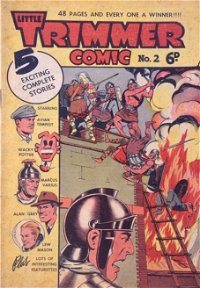Twice Approved by James Zee
The mystery of Cleland and Approved Publications
I've been puzzled by the publisher of the rare Australian series Little Trimmer Comic, but I've not seen a copy until recently.11Thanks to a scanned issue at Comic Book +. Accessed 1 April 2014....
It's one of those situations where I've wondered if respected Australian comics' historian John Ryan 'got it wrong'.
The earliest issues are small pocket format, but the series varied in size over its 22 issues. At least one issue was printed landscape, another square and later issues are standard US format.
It contained diverse Australian-drawn stories such Avian Tempest (war adventure), Lieutenant Lew Mason (science fiction), Marcus Varius (historical), Alan Grey and humorous fillers such as Wacky Potter and Lou Blue—the Blunder Bloke. While Little Trimmer remained on the cover, Avian Tempest took over the title before the end.
Ryan reports the stories are unsigned, but concludes they appear to have been produced by the Eric Porter Studio.22John Ryan (1979), Panel by Panel, Cassell Australia, Stanmore NSW, p. 206-207. All references to Ryan in this article are... It's clear that not all of the artwork is by pioneering Australian animator Eric Porter, though. Stories in issue #14 are signed "Terry Murphy" or "T.M." and Mick Stone's checklist identifies Terry Murphy and Albert DeVine as working on Avian Tempest.33Mick Stone, "Australian Comics 1900-1960: A Checklist" in Annette Shiell, Ed. (1998), Bonzer: Australian comics 1900s–1990s, Elgua Media, Redhill South,... Joan Kerr reports Carl Lyon also worked on the series.44See Carl Raymond Lyon at Design & Art Australia Online (accessed 5 April 2014). Note that dating Lyon's work...
Ryan also implies that this undated series began after 1953 when Fawcett ceased publishing Captain Marvel comics and Cleland was pursuing new strategies to maintain its line of comics. Mick Stone's dating of "c. 1950-54" seems more likely to provide an accurate start date. I think the series probably ran from 1950 to 1952.55Based on the contents of Little Trimmer Comic #14, the series appears to have run 1950-1952 if it was generally...
Those are minor errors, but here's the real mystery—without explanation or comment, Ryan treats Larry S. Cleland as the publisher of Little Trimmer.
In contrast, Mick Stone reports Frank James as publisher. Monash Uni says Frank Douglas James66Science Fiction: An Exhibition of Material from the Rare Book Collection, based on issue #3. Accessed 2 April 2014.... and, according to the National Library of Australia, the publisher is Frank Douglas James for Approved Publications.77catalogue.nla.gov.au/Record/201876, based on issue #11. Accessed 2 April 2014. This record is part of the John Ryan Comic Collection.... Roger and Edda Morrison also list Approved Publications.88Roger and Edda Morrison, Australian Comics 1924-1966: an index and price guide, Forster, NSW: Comic Book Nostalgia, c1997....
The trend seems against Ryan and, in fact, the indicia of Avian Tempest #14 reads:
Published by Frank Douglas James, of 96 Burlington Street, Oakleigh, for Approved Publications Pty. Ltd., 129 Swanston Street, Melbourne.
This aligns with partial information from other sources. The only other comic that clearly has the same distinctive publisher information is Steven Carlisle Illustrated Adventures (1954?-1955?), which Ryan also treats as a Cleland publication.
While "Frank Douglas James" is unknown, there are many comics with the listed publisher "Approved Publications", generally dating from 1955 to 1957—later than Little Trimmer and Steven Carlisle.
These comics are from Sydney-based Magazine Management, a publisher that used multiple names, including Barmor, Champion, Illustrated, Jubilee, Junior Readers, Red Circle and Rosnock. It also had international partners at various times, including in New Zealand in the late 1950s.
It seems likely that the Melbourne-based Approved Publications was just another aspect of that company, later absorbed into its Sydney offices. So could Ryan be wrong?




